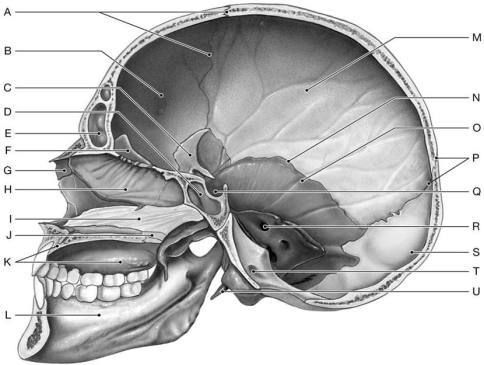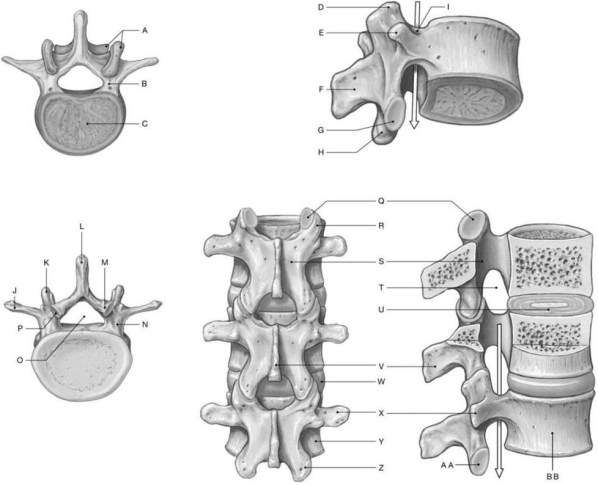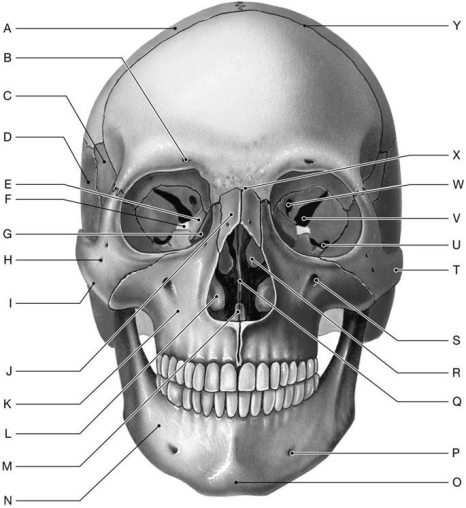A) frontal bone
B) sphenoid bone
C) ethmoid bone
D) zygomatic bone
E) maxilla
G) A) and E)
Correct Answer

verified
Correct Answer
verified
Multiple Choice
Bones of the axial skeleton form the ________ axis of the body.
A) transverse
B) coronal
C) longitudinal
D) horizontal
E) diagonal
G) A) and E)
Correct Answer

verified
Correct Answer
verified
Multiple Choice
Figure 6.3
 Using the above-referenced figure of the midsagittal view of the right side of the skull, identify the specified labeled part in each of the following questions.
-Identify the structure indicated by Label J.
Using the above-referenced figure of the midsagittal view of the right side of the skull, identify the specified labeled part in each of the following questions.
-Identify the structure indicated by Label J.
A) Vomer
B) Palatine bone
C) Cribriform plate of ethmoid
D) Maxilla
E) Perpendicular plate of ethmoid
G) A) and C)
Correct Answer

verified
Correct Answer
verified
Multiple Choice
Features of the maxillae include ________.
A) sinuses
B) alveolar processes
C) orbital surfaces
D) infra-orbital groove
E) All of the answers are correct.
G) A) and E)
Correct Answer

verified
Correct Answer
verified
Multiple Choice
The major function of the vertebral body is to ________.
A) allow twisting motions
B) provide support
C) protect the spinal cord
D) transfer weight along the axis of the vertebral column
E) provide a passageway for nerves
G) B) and C)
Correct Answer

verified
Correct Answer
verified
Multiple Choice
Figure 6.4
 Using the above-referenced figures of the anatomy of a typical vertebra (superior, lateral and slightly inferior, and inferior views) and the arrangement of articulations between vertebrae, identify the specified labeled part in each of the following questions.
-Identify the structure indicated by Label U.
Using the above-referenced figures of the anatomy of a typical vertebra (superior, lateral and slightly inferior, and inferior views) and the arrangement of articulations between vertebrae, identify the specified labeled part in each of the following questions.
-Identify the structure indicated by Label U.
A) Intervertebral foramen
B) Lamina
C) Intervertebral disc
D) Vertebral arch
E) Vertebral body
G) B) and E)
Correct Answer

verified
Correct Answer
verified
Multiple Choice
Which region of the vertebral column forms interlocking vertebral bodies that permit a relatively greater degree of flexibility than do those of other regions?
A) cervical
B) thoracic
C) lumbar
D) sacral
E) coccygeal
G) A) and B)
Correct Answer

verified
Correct Answer
verified
Multiple Choice
Figure 6.2
 Using the above-referenced figure of the anterior view of the bones of the adult skull, identify the specified labeled items in each of the following questions.
-Identify the structure indicated by Label L.
Using the above-referenced figure of the anterior view of the bones of the adult skull, identify the specified labeled items in each of the following questions.
-Identify the structure indicated by Label L.
A) Nasal bone
B) Vomer
C) Inferior nasal concha
D) Lacrimal bone
E) Middle nasal concha
G) B) and C)
Correct Answer

verified
Correct Answer
verified
Multiple Choice
Figure 6.4
 Using the above-referenced figures of the anatomy of a typical vertebra (superior, lateral and slightly inferior, and inferior views) and the arrangement of articulations between vertebrae, identify the specified labeled part in each of the following questions.
-Identify the structure indicated by Label F.
Using the above-referenced figures of the anatomy of a typical vertebra (superior, lateral and slightly inferior, and inferior views) and the arrangement of articulations between vertebrae, identify the specified labeled part in each of the following questions.
-Identify the structure indicated by Label F.
A) Transverse process
B) Superior articular process
C) Vertebral arch
D) Spinous process
E) Inferior articular process
G) D) and E)
Correct Answer

verified
Correct Answer
verified
Multiple Choice
The ethmoid contains ________.
A) an interconnected network of air cells, which produce mucous secretions that flush the surfaces of the nasal cavities
B) the cribriform plate, which is perforated by foramina
C) a perpendicular plate, which forms the superior part of the nasal septum
D) a prominent bony ridge to which is attached the falx cerebri, a membrane that stabilizes the position of the brain
E) All of the answers are correct.
G) A) and B)
Correct Answer

verified
Correct Answer
verified
Showing 141 - 150 of 150
Related Exams